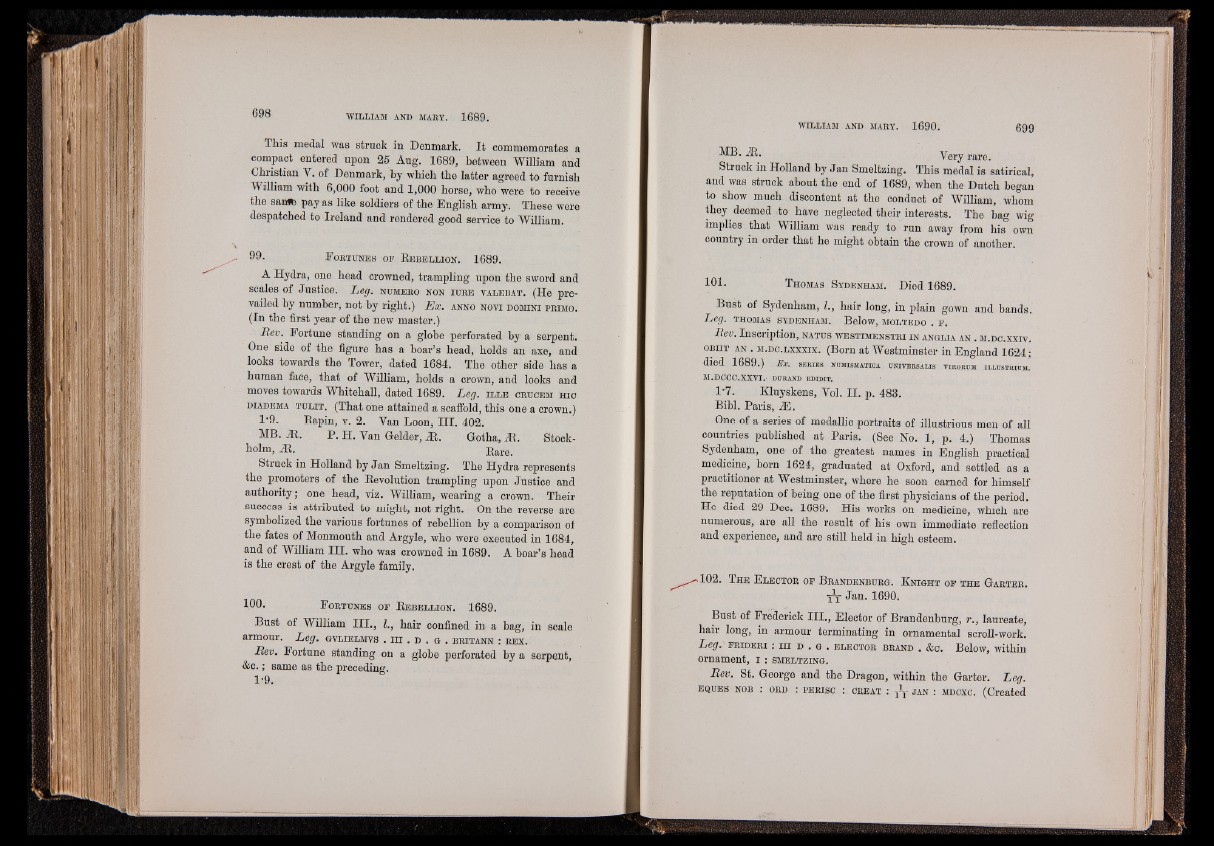
This medal was struck in Denmark. It commemorates a
compact entered upon 25 Aug. 1689, between William and
Christian V. of Denmark, by which the latter agreed to furnish
William with 6,000 foot and 1,000 horse, who were to receive
the sanft pay as like soldiers of the English army. These were
despatched to Ireland and rendered good service to William.
" • F o b t u n e s o f E e b e l l io n . 1689.
A Hydra, one head crowned, trampling upon the sword and
scales of Justice. Leg. n um e b o n on iu b e y a l e b a t . (He prevailed
by number, not by right.) Ex. anno n o v i d om in i p e im o .
(In the first year of the new master.)
Rev. Fortune standing on a globe perforated by a serpent.
One side of the figure has a boar’s head, holds an axe, and
looks towards the Tower, dated 1684. The other side has a
human face, that of William, holds a crown, and looks and
moves towards Whitehall, dated 1689. Leg. il l e c b ijc em h ic
d ia d em a t u l it . (That one attained a scaffold, this one a crown.)
1-9. Rapin, v. 2. Van Loon, III. 402.
MB. At. P. H. Van Gelder, At. Gotha, At. Stockholm,
At. Bare.
Struck in Holland by Jan Smeltzing. The Hydra represents
the promoters of the Bevolution trampling upon Justice and
authority; one head, viz. William, wearing a crown. Their
success is attributed to might, not right. On the reverse are
symbolized the various fortunes of rebellion by a comparison ol
the fates of Monmouth and Argyle, who were executed in 1684,
and of William IH. who was crowned in 1689. A boar’s head
is the crest of the Argyle family.
100> F o b t u n e s o f R e b e l l io n . 1689.
Bust of William III., I., hair confined in a bag, in scale
armour. Leg. gvllelmvs . i i i . d . g . b e it a n n : e e x .
Rev. Fortune standing on a globe perforated by a serpent,
&c.; same as the preceding.
1-9.
MB. At. Very rare.
Struck in Holland by Jan Smeltzing. This medal is satirical,
and was struck about the end of 1689, when the Dutch began
to show much discontent at the conduct of William, whom
they deemed to have neglected their interests. The bag wig
implies that William was ready to run away from his own
country in order that he might obtain the crown of another.
101. T homas S y d en h am . Died 1689.
Bust of Sydenham, I , hair long, in plain gown and bands.
Leg. thomas Sy d en h am . Below, m o l t ed o . f .
Rev. Inscription, n a t u s w e s t im e n s t e i i n a n g l i a a n . m .d c .x x iv .
o b i i t a n . m .d c .lx x x ix . (Born at Westminster in England 1624;
died 1689.) Ex. s e r ie s n u m ism a t io a u n iv e r s a l i s v ir o r u m i l l u s t r iu m .
M.DCCC.XXVI. DURAND EDIDIT.
1‘7. Kluyskens, Vol. II. p. 483.
Bibl. Paris, AS.
One of a series of medallic portraits of illustrious men of all
countries published at Paris. (See No. 1, p. 4.) Thomas
Sydenham, one of the greatest names in English practical
medicine, born 1624, graduated at Oxford, and settled as a
practitioner at Westminster, where he soon earned for himself
the reputation of being one of the first physicians of the period.
He died 29 Dec. 1689. His works on medicine, which are
numerous, are all the result of his own immediate reflection
and experience, and are still held in high esteem.
1102. T h e E l e c t o e o f B b a n d e n b u e g . K n ig h t o f t h e G a e t e e .
Jan. 1690.
Bust of Frederick III., Elector of Brandenburg, r., laureate,
hair long, in armour terminating in ornamental scroll-work.
Leg. f e id e r i ; i i i d . g . e l e c t o r b ra n d . & c . Below, within
ornament, i : sm e l t z in g .